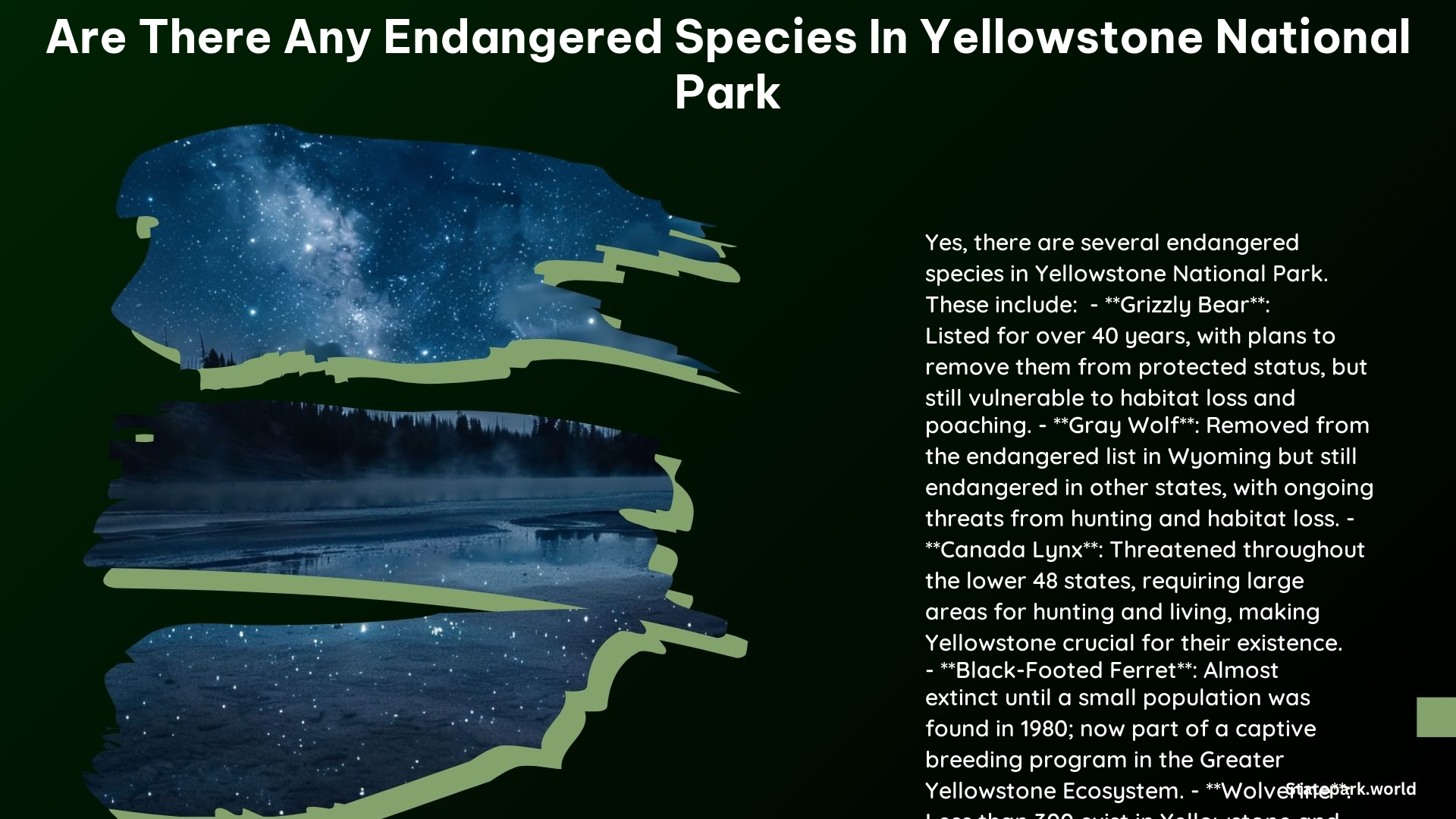Yes, there are several endangered species found within the boundaries of Yellowstone National Park. Yellowstone is home to a diverse array of wildlife, some of which are facing significant threats to their survival. In this blog post, we’ll explore the endangered species that call Yellowstone home and the efforts being made to protect them.
Grizzly Bears: Iconic Symbols of Yellowstone
One of the most well-known endangered species in Yellowstone is the grizzly bear. Grizzly bears were listed as a threatened species under the Endangered Species Act in 1975 due to a significant decline in their population. While conservation efforts have led to a gradual recovery, grizzly bears still face numerous threats, including habitat loss, human-bear conflicts, and climate change.
Yellowstone National Park is a crucial habitat for grizzly bears, providing them with the food, shelter, and space they need to thrive. The park’s vast wilderness areas and abundant food sources, such as elk, bison, and whitebark pine nuts, make it an ideal home for these majestic creatures.
Gray Wolves: Reintroduced to Yellowstone

Another endangered species found in Yellowstone is the gray wolf. Gray wolves were once native to the park but were nearly eradicated in the early 20th century due to hunting and predator control programs. In the 1990s, however, gray wolves were reintroduced to Yellowstone, and their population has since grown steadily.
Today, Yellowstone is home to a thriving population of gray wolves, which play a vital role in the park’s ecosystem. These apex predators help to regulate the populations of other species, such as elk and deer, and contribute to the overall health of the ecosystem.
Despite the success of the wolf reintroduction program, gray wolves remain listed as endangered in some states, and their long-term survival in Yellowstone is still uncertain.
Wolverines: Elusive Inhabitants of Yellowstone
Wolverines are another endangered species found in Yellowstone National Park. These large, powerful members of the weasel family are known for their fierce and solitary nature, and they are found in only a few remote areas of the western United States, including Yellowstone.
Wolverines are particularly vulnerable to the effects of climate change, as they rely on deep, persistent snow cover to survive and raise their young. As temperatures rise and snowpack decreases, the habitat for wolverines is shrinking, putting their long-term survival at risk.
Yellowstone’s vast wilderness areas and high-elevation habitats provide an important refuge for the remaining wolverine population, but more research and conservation efforts are needed to ensure their continued presence in the park.
Canada Lynx: Threatened Felines of Yellowstone
The Canada lynx is another endangered species found in Yellowstone National Park. These elusive felines are listed as a threatened species under the Endangered Species Act, and their populations are declining due to habitat loss, fragmentation, and climate change.
Yellowstone’s dense forests and rugged terrain provide ideal habitat for Canada lynx, and the park is home to a small but important population of these cats. However, their numbers are still low, and they face ongoing threats from human activities, such as logging and recreational use of their habitat.
Black-Footed Ferrets: Reintroduction Efforts in the Greater Yellowstone Ecosystem
While the black-footed ferret is not currently known to reside within the boundaries of Yellowstone National Park, it is an endangered species that is found in the Greater Yellowstone Ecosystem. These small, weasel-like creatures were once thought to be extinct, but a captive breeding program has allowed for their reintroduction to several areas, including the Greater Yellowstone region.
The success of the black-footed ferret reintroduction program is crucial for the long-term survival of the species, and Yellowstone’s vast grasslands and prairie habitats provide an important refuge for these endangered animals.
Pikas: Sentinels of Climate Change
Finally, the pika is a small, rabbit-like mammal that is not yet listed as endangered, but is facing significant threats due to climate change. Pikas are found in the high-elevation, alpine habitats of Yellowstone, and they are particularly sensitive to changes in temperature and precipitation.
As the climate warms, the habitat for pikas is shrinking, and their populations are declining. While they are not currently listed as endangered, many scientists and environmentalists are pushing for their designation as a threatened or endangered species, in order to spur greater conservation efforts.
Conclusion
Yellowstone National Park is home to a diverse array of wildlife, some of which are facing significant threats to their survival. From the iconic grizzly bear to the elusive wolverine, these endangered species are a vital part of the park’s ecosystem and deserve our protection.
Through ongoing conservation efforts, research, and public education, we can work to ensure that these endangered species continue to thrive in Yellowstone for generations to come. By protecting the park’s unique habitats and supporting the recovery of these threatened animals, we can help to preserve the natural wonders of Yellowstone for all to enjoy.
References:
- Julia Barton, “50 Years: How the Endangered Species Act Influenced Greater Yellowstone,” Mountain Journal, January 2, 2024.
- Slone Wayking, “Endangered Species in Yellowstone,” Pets on Mom.com.
- “5 Endangered Animal Species of Yellowstone National Park,” Sunnysports, July 31, 2017.
- “Endangered Species/Human Impact – Yellowstone National Park,” Yellowstone Project Info.
- “Yellowstone National Park – Endangered Ecosystems,” Endangered Wonders.
